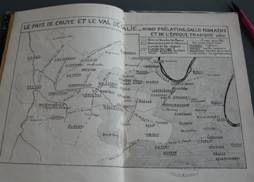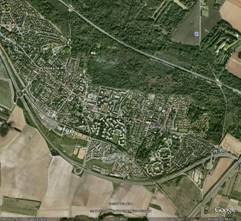A brief history of Bailly
Bailly over time
The origins of Bailly are related to the clearing of the Val de Gally whose small river, the Ru de Gally,winds from Versailles to the Mauldre, a tributary of the Seine. The prehistoric men have ascended its banks, the Celts have followed the Gauls attracted by the situation away from the well stocked with game-rich forest Cruys (hard ground) and well exposed in the northern edge of the Valley, rich in water, it will implement the first sedentary habitats. |

|
In Gallo-Roman, a vicus formed into a rectangle around the villa of a dignitary, take the name of it: Batallius which is added the suffix "acum" Batallius-acum, which came fast enough "Bataliacum" then Balliacum, whence is derived the name of the people ... to the Roman era: Baalei which gradually turns into Bailiff, and more recently in Bailly.
By this time appear the characteristics of our region: culture, habitat, traffic routes, under the influence of two major tribes: the Parisii, East and "Carnutes" in the West.
Keeping the old tradition, the Christian period will follow the boundaries of cities and thus Bailly and surrounding parishes will form an enclave of the diocese of Chartres in the edge of Paris.
The Middle Ages was a very tough: poeple group together around "lumps" these wooden towers surrounded by fortifications where they took refuge in the approach of danger. It is no doubt this time that are the main strongholds of Bailly-le-Haut, on the edge of the forest Cruys, but on the plateau, and that of Bailly-le-Bas, substantially at the location of the village present and which will own all the lords of the fiefs corresponding to Noisy and Bailly.
The Normans in the ninth century, landing of the Seine, in the outskirts ravage during raids.
Between the tenth century and the thirteenth century, the Val de "Galie" organized under the leadership of the abbeys of Saint-Denis and Sainte-Genevieve. The growing population of this period allows the development of land, construction of villages around the stone churches (Saint-Sulpice Bailly), the vocation and the countryside will be set.
This golden age ended, the Black Death of 1348-1349 and the Hundred Years War, decimating populations and changing land in fallow:
Since 1346, Edward III of England and the region occupies Poissy, his son, the Prince of Wales, who settled in Saint-Germain, will burn by retirement, all the surrounding villages.

In 1357, Charles the bad, his supporters and the English hold Maule and Villepreux, Val de Gallie becomes a battlefield almost constant until the defeat of the enemy beated at Beynes in the early fifteenth century at a place called "taking the English."
The Lords of Bailly restore their fields. Peace restored, for a moment troubled by religious wars, engenders new life, in the territory of Bailly, small hamlets are being developed: Pontalis with its castle, the Hotel mills, Moulineaux Voluceau; on the Ru de Gally, three fish farms and two mills are installed. The abbey of Sainte-Genevieve, Montbuisson, Saint-Denis, Saint-Cyr or Vaux Cernay share in turn the land and the taxations.
This return to prosperity also allows the construction of the Castle of St. Catherine Bailly by Benoist (1526). This castle was completed by the family of Ligneris. Theodore Ligneris yield in 1571 to Albert de Gondi, the future Marshal de Retz. His heirs and successors will continue the development by combining the properties.
The focus of interest is Saint-Germain before becoming Versailles. Vincent de Paul, then tutor to the children of Philippe-Emmanuel de Gondi, residing Villepreux, preached a mission.The Cross at the beginning of the Church Street is in memory.
The Fronde goes on.
Part of the Country Cruys and Val de Gally was acquired by Louis XIV, following the collapse of François Bossuet, a relative of the Eagle of Meaux, in May 20, 1676, to expand the area of Versailles hunting grounds.
The annexation involves adjustments as the Pheasant or ponds and Champ de Mars of the plain of Trou d'Enfert.
The Revolution return the land to private property.The purchaser from Versailles destroyed the chapel of Notre-Dame de Bon Repos, the ancestral shrine of the entire region, but the statue of Our Lady found shelter in the church of Bailly
Bailly found his vocation as a farming village in his vineyards, vines his fields and orchards.
The nineteenth century saw the restoration of the castle of Tillet, the construction of a tree nursery, the Chestnut and a few other smaller properties. The land is exploited by farmers, gardeners, florists and horticulturists. The Great Belt Line is created. Bailly receive a halt.
The armed conflicts of the last two centuries, the construction of the Railway or the Western State Highway West led families from other provinces, northern Ardennes, Brittany, to fix and often to merge with those of former Baillacois many of whom were themselves descendants of the great servants of the royal domain.
Since 1950, the expansion of the Paris region to the west leads to Bailly implantation of a new generation of collective and suburban habitats in places whose names evoke the spirit of a small city where life is good . |

|

